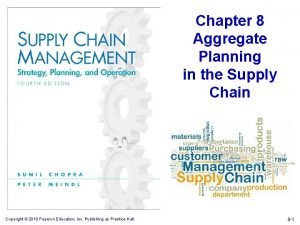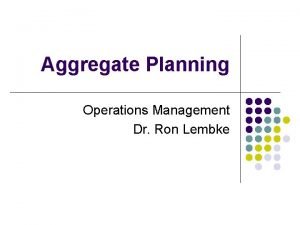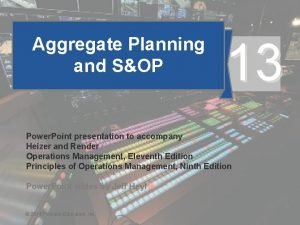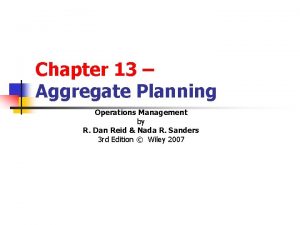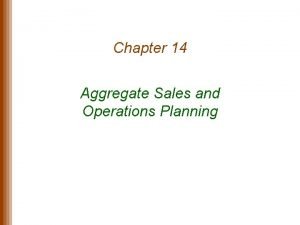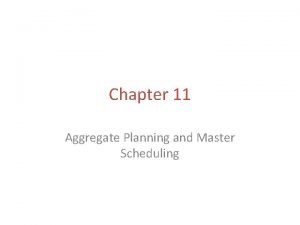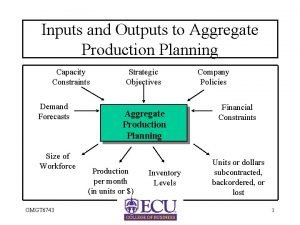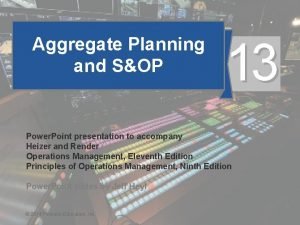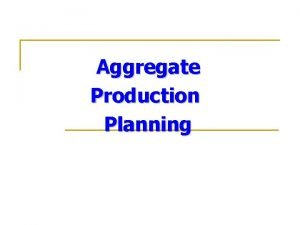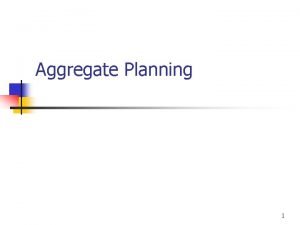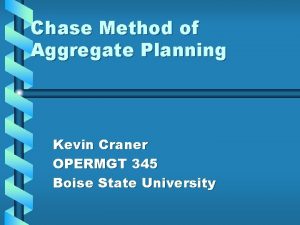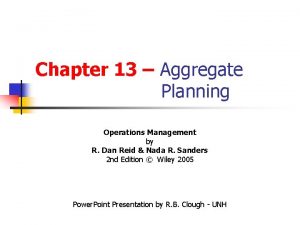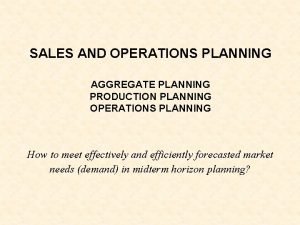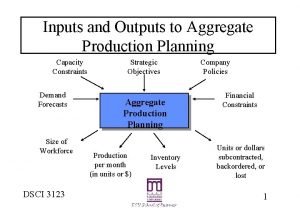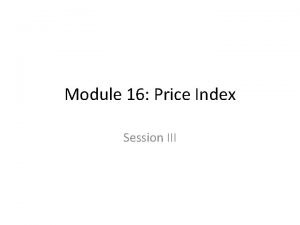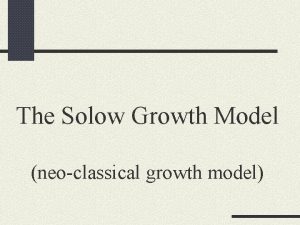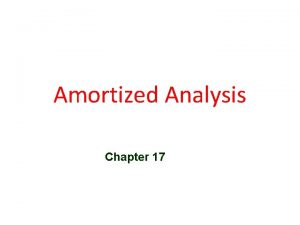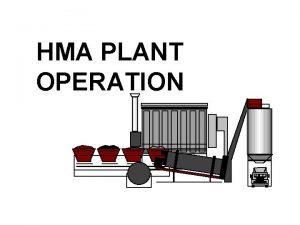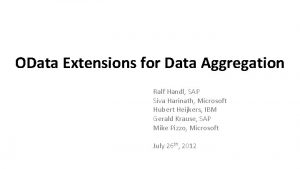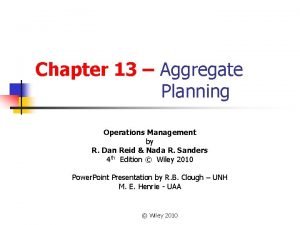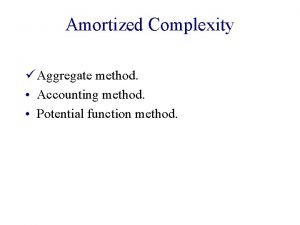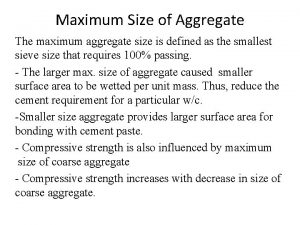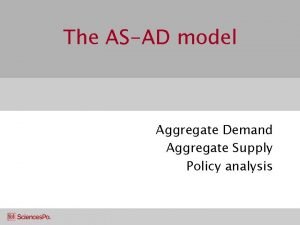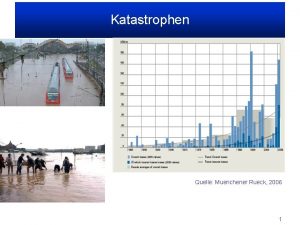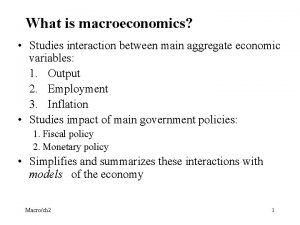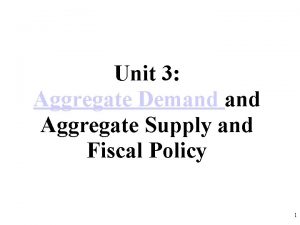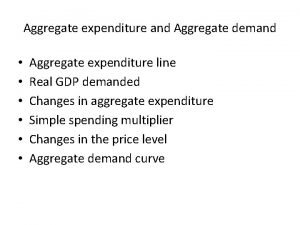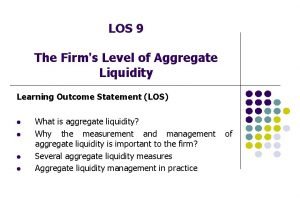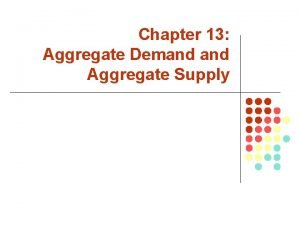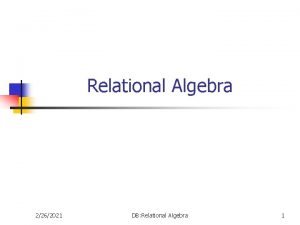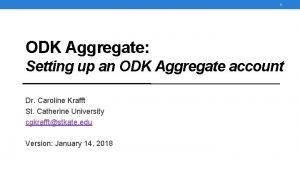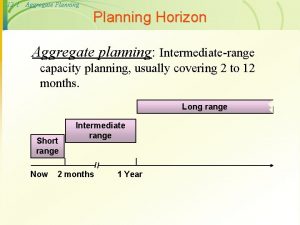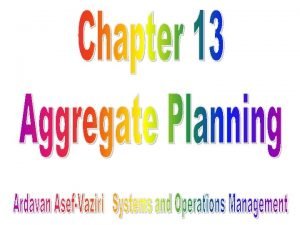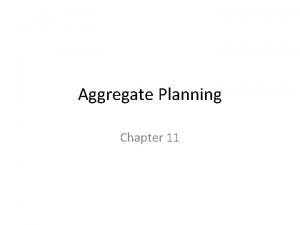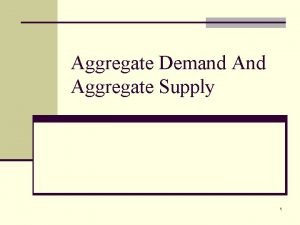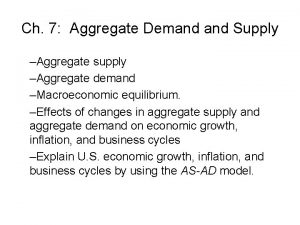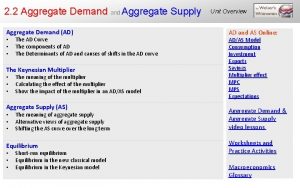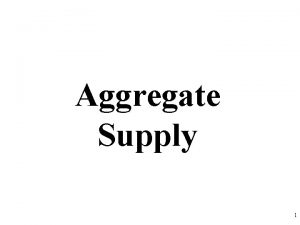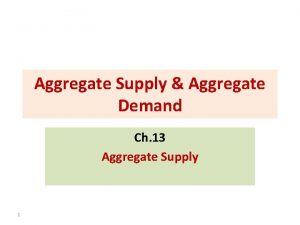Aggregate Planning 2 Aggregate Planning Aggregate planning Intermediaterange



























































































- Slides: 91

Aggregate Planning

2 Aggregate Planning • Aggregate planning – Intermediate-range capacity planning that typically covers a time horizon of 2 to 18 months – Useful for organizations that experience seasonal, or other variations in demand – Goal: • Achieve a production plan that will effectively utilize the organizations’ resources to satisfy demand ©The Mc. Graw-Hill Companies, Inc. , 2004

3 Sales and Operations Planning • Some organizations use the term sales operations and planning rather than aggregate planning – Sales and operation planning • Intermediate-range planning decisions to balance supply and demand, integrating financial and operations planning • Since the plan affects functions throughout the organization, it is typically prepared with inputs from sales, finance, and operations ©The Mc. Graw-Hill Companies, Inc. , 2004

4 Planning Levels ©The Mc. Graw-Hill Companies, Inc. , 2004

5 Planning Tasks and Responsibilities ©The Mc. Graw-Hill Companies, Inc. , 2004

Planning Horizon Long range Short range Now Intermediate range 6 months 18 months

Process planning Long range Strategic capacity planning Intermediate Forecasting & demand range management Manufacturing Sales and operations (aggregate) planning Sales plan Aggregate operations plan Services Master scheduling Material requirements planning Short range Order scheduling Weekly workforce and customer scheduling Daily workforce and customer scheduling

8 The Planning Sequence Corporate strategies and policies Economic, competitive and political conditions Aggregate demand forecasts Business Plan Establishes operations and capacity strategies Aggregate Plan Establishes operations capacity Master Schedule Establishes schedules for specific products ©The Mc. Graw-Hill Companies, Inc. , 2004

Operations Planning Activities • Long-range planning – – Greater than one year planning horizon Usually performed in annual increments • Medium-range planning – – Six to eighteen months Usually with monthly or quarterly increments • Short-range planning – – One day to less than six months Usually with weekly increments

10 Aggregation • The plan must be in units of measurement that can be understood by the firm’s non-operations personnel • Aggregate units of output per month • Dollar value of total monthly output • Total output by factory • Measures that relate to capacity such as labor hours ©The Mc. Graw-Hill Companies, Inc. , 2004

11 Dealing with Variation • Most organizations use rolling 3, 6, 9 and 12 month forecasts – Forecasts are updated periodically, rather than relying on a once-a-year forecast ©The Mc. Graw-Hill Companies, Inc. , 2004

12 Dealing with Variation • Strategies to counter variation: – Maintain a certain amount of excess capacity to handle increases in demand – Maintain a degree of flexibility in dealing with changes • Hiring temporary workers • Using overtime – Wait as long as possible before committing to a certain level of supply capacity • Schedule products or services with known demands first • Wait to schedule other products until their demands become less uncertain ©The Mc. Graw-Hill Companies, Inc. , 2004

13 Overview of Aggregate Planning Forecast of aggregate demand for the intermediate range Develop a general plan to meet demand requirements Update the aggregate plan periodically (e. g. , monthly) ©The Mc. Graw-Hill Companies, Inc. , 2004

14 Demand Supply • Aggregate planners are concerned with the – Demand quantity • If demand exceeds capacity, attempt to achieve balance by altering capacity, demand, or both – Timing of demand • Even if demand capacity are approximately equal, planners still often have to deal with uneven demand within the planning period ©The Mc. Graw-Hill Companies, Inc. , 2004

Aggregate Production Planning (APP) ü Matches market demand to company resources ü Plans production 6 months to 18 months in advance ü Expresses demand, resources, and capacity in general terms ü Develops a strategy for economically meeting demand ü Establishes a company-wide game plan for allocating resources

Balancing Aggregate Demand Aggregate Production Capacity Suppose the figure to the right represents forecast demand in units Now suppose this lower figure represents the aggregate capacity of the company to meet demand 10000 8000 6000 7000 6000 5500 4000 2000 0 10000 Jan Feb 9000 Jan Feb Mar 9900 Apr 8800 May Jun 9500 May Jun 8000 What we want to do is balance out the production rate, workforce levels, and inventory to make these figures match up 6000 4000 2000 0 Mar Apr

Aggregate Plan: Relationships Marketplace and Demand Forecasts, orders Product Decisions Process Planning & Capacity Decisions Aggregate Plan for Production Master Production Schedule, and MRP systems Detailed Work Schedules Research and Technology Work Force Raw Materials Available Inventory On Hand External Capacity Subcontractors

Inputs and Outputs to APP Capacity Constraints Demand Forecasts Size of Workforce Strategic Objectives Aggregate Production Planning Production per month (in units or $) Inventory Levels Company Policies Financial Constraints Units or dollars subcontracted, backordered, or lost

Aggregate Planning Inputs Ø Resources Ø Common unit for • Workforce/production rates measuring outputs • Facilities and equipment Ø Costs Ø Demand forecast • Inventory carrying • Back orders Ø Policies • • • Workforce changes Subcontracting Overtime Inventory levels/changes Back orders • • Hiring/firing Overtime Inventory changes Subcontracting

20 Aggregate Planning Outputs • Total cost of a plan • Projected levels of – Inventory – Output (units completed per unit time) – Employment (workforce level-no. of workers) – Subcontracting levels (if any) – Backordering levels (if any) ©The Mc. Graw-Hill Companies, Inc. , 2004

Aggregate Planning Goals • • Meet demand Use capacity efficiently Meet inventory policy Minimize total cost

Aggregate Planning Strategies • Proactive – Alter demand to match capacity • Reactive – Alter capacity to match demand • Mixed – Some of each

Demand Management Options ü Shifting demand from peak to off-peak periods by incentives, promotions, advertising campaigns, pricing (price elasticity important) etc. ü Offering product or services with counterseasonal demand patterns (counterseasonal product mixing) ü Backordering (orders are taken in one period and deliveries promised for a later period ü Creation of new demand ü Partnering with suppliers to reduce information distortion along the supply chain

Adjusting Capacity to Meet Demand (Supply Options) (1 of 2) Ø Producing at a constant rate and using inventories to absorb fluctuations in demand ie. changing inventory levels Ø Varying work force size (hiring and firing workers) so that production matches demand Ø Varying production capacity by increasing or decreasing working hours (overtime or idle time)

Options of Adjusting Capacity to Meet Demand (2 of 2) Ø Using part-time workers to change production rate Ø Subcontracting work to other firms Ø Providing the service or product at a later time period (backordering)

Strategy Details Ø Overtime & undertime - common when demand fluctuations are not extreme Ø Subcontracting - useful if supplier meets quality & time requirements Ø Part-time workers - feasible for unskilled jobs or if labor pool exists Ø Backordering - only works if customer is willing to wait for product/services

Capacity Options - Advantages and Disadvantages (1 of 4) Option Advantage Disadvantage Some Comments Changing inventory levels Changes in human resources are gradual, not abrupt production changes Inventory holding costs; Shortages may result in lost sales Applies mainly to production, not service, operations Varying workforce size by hiring or layoffs Avoids use of other alternatives Hiring, layoff, and training costs Used where size of labor pool is large

Advantages/Disadvantages (2 of 4) Option Advantage Disadvantage Some Comments Varying production rates through overtime or idle time Matches seasonal fluctuations without hiring/training costs Permits flexibility and smoothing of the firm's output Overtime premiums, tired workers, may not meet demand Allows flexibility within the aggregate plan Loss of quality control; reduced profits; loss of future business Applies mainly in production settings Subcontracting

Advantages/Disadvantages (3 of 4) Option Advantage Disadvantage Some Comments Using part-time workers Less costly and more flexible than full-time workers Good for unskilled jobs in areas with large temporary labor pools Influencing demand Tries to use excess capacity. Discounts draw new customers. High turnover/training costs; quality suffers; scheduling difficult Uncertainty in demand. Hard to match demand to supply exactly. Creates marketing ideas. Overbooking used in some businesses.

Advantages/Disadvantages (4 of 4) Option Advantage Disadvantage Some Comments Back ordering during highdemand periods May avoid Customer must overtime. Keeps be willing to capacity constant wait, but goodwill is lost. Many companies backorder. Counterseasonal Fully utilizes May require products and resources; allows skills or service mixing stable workforce. equipment outside a firm's areas of expertise. Risky finding products or services with opposite demand patterns.

The Extremes Level Strategy Chase Strateg y Production rate is constant Production equals demand

Basic Aggregate Planning Strategies for Meeting Demand ØLevel capacity strategy: • Keeping work force constant and maintaining a steady rate of regular-time output while meeting variations in demand by a combination of options (such as using inventories +overtime+part-time workers+backorders subcontracting) ØChase demand strategy: • Changing workforce levels so that production matches demand (the planned output for a period is set at the expected demand for that period. ) ØMaintaining resources for high demand levels • Ensures high levels of customer service

33 Chase Approach • Capacities are adjusted to match demand requirements over the planning horizon – Advantages • Investment in inventory is low • Labor utilization in high – Disadvantages • The cost of adjusting output rates and/or workforce levels ©The Mc. Graw-Hill Companies, Inc. , 2004

34 Level Approach • Capacities are kept constant over the planning horizon • Advantages – Stable output rates and workforce • Disadvantages – Greater inventory costs – Increased overtime and idle time – Resource utilizations vary over time ©The Mc. Graw-Hill Companies, Inc. , 2004

Level Production Demand Units Production Time

Chase Demand Units Production Time

Level Strategy: Forecast and Average Forecast Demand 22 20 18 21 21 22

Level Strategy: Cumulative Demand Graph 7, 00 0 Cumulative Demand (Units) 6, 00 0 5, 00 0 4, 00 0 3, 00 0 Reduction Cumulative of inventory level production using average monthly forecast requirements Cumulative forecast requirements Excess inventory Jan Feb Mar Apr May 2, 00 Jun

Aggregate Planning Methods Ø Graphical & charting techniques • Popular & easy-to-understand • Trial & error approach Ø Mathematical approaches • Linear programming • Transportation method • Linear decision rule (LDR) • Search decision rule (SDR) • Management coefficients model • Simulation models (Computerized models that can be tested under different scenarios to identify acceptable solutions to problems

Summary of Planning Techniques

41 Trial-and-Error Techniques • Trial-and-error approaches consist of developing simple table or graphs that enable planners to visually compare projected demand requirements with existing capacity • Alternatives are compared based on their total costs • Disadvantage of such an approach is that it does not necessarily result in an optimal aggregate plan ©The Mc. Graw-Hill Companies, Inc. , 2004

Steps of Trial & Error Method 1. Forecast demand for each period 2. Determine capacities (for regular time, overtime, subcontracting) for each period 3. Identify policies that are pertinent 4. Determine costs (labor, hiring/firing, holding etc. ) 5. Develop alternative plans and costs 6. Select the best plan that satisfies objectives. Otherwise return to step 5.

43 Trial-and-Error Technique Assumptions • The regular output capacity is the same in all periods • Cost is a linear function composed of unit cost and number of units • Plans are feasible • All costs are associated with a decision option can be represented by a lump sum • Cost figures can be reasonably estimated and are constant for the planning period • Inventories are built up and drawn down at a uniform rate throughout each period • Backlogs are treated as if they exist the entire period ©The Mc. Graw-Hill Companies, Inc. , 2004

44 Cumulative output/demand Cumulative Graph Inventory Shortage Inventory Build Up Cumulative production Cumulative demand Period ©The Mc. Graw-Hill Companies, Inc. , 2004

Aggregate Planning Using Pure Strategies- Example 1 (1 of 4) QUARTER Spring Summer Fall Winter Hiring cost Firing cost Inventory carrying cost Production per employee Beginning work force SALES FORECAST (LB) 80, 000 50, 000 120, 000 150, 000 = $100 per worker = $500 per worker = $0. 50 pound per quarter = 1, 000 pounds per quarter = 100 workers

Example 1: Level Production Strategy (2 of 4) QUARTER SALES FORECAST (LB) Spring Summer Fall Winter 80, 000 50, 000 120, 000 150, 000 Level production (50, 000 + 120, 000 + 150, 000 + 80, 000) 4 = 100, 000 pounds

Example 1: Level Production Strategy (3 of 4) QUARTER Spring Summer Fall Winter SALES FORECAST 80, 000 50, 000 120, 000 150, 000 Total PRODUCTION PLAN INVENTORY 100, 000 400, 000 20, 000 70, 000 50, 000 0 140, 000 Cost = 140, 000 pounds x 0. 50 per pound = $70, 000

Example 1: Chase Demand Strategy (4 of 4) QUARTER SALES PRODUCTION FORECAST PLAN Spring Summer Fall Winter 80, 000 50, 000 120, 000 150, 000 WORKERS NEEDED 80 50 120 150 WORKERS HIRED FIRED 0 0 70 30 20 30 0 0 100 50 Cost = (100 workers hired x $100) + (50 workers fired x $500) = $10, 000 + 25, 000 = $35, 000

MONTH January February March April May June Aggregate Planning: Example 2 DEMAND (CASES) 1000 400 400 400 MONTH July August September October November December DEMAND (CASES) 500 1000 1500 2500 3000 Production per employee = 100 cases per month Wage rate = $10 per case for regular production = $15 per case for overtime = $25 for subcontracting Hiring cost = $1000 per worker Firing cost = $500 per worker Inventory carrying cost = $1. 00 case per month Beginning work force = 10 workers

Aggregate Planning: Example 3 (1 of 8) Suppose we have the following unit demand cost information: Demand/mo Jan Feb Mar Apr May Jun 4500 5500 7000 10000 8000 6000 Materials Holding costs Marginal cost of stockout Hiring and training cost Layoff costs Labor hours required Straight time labor cost Beginning inventory Productive hours/worker/day Paid straight hrs/day $5/unit $1/unit per mo. $1. 25/unit per mo. $200/worker $250/worker 0. 15 hrs/unit $8/hour 250 units 7. 25 8

Example 3: Determining Output and Straight Labor Costs(2 of 8) Given the demand cost information below, what are the aggregate hours/worker/month, units/worker, and dollars/worker? Demand/mo Jun Jan Feb Mar Apr May 4500 5500 7000 10000 8000 6000 7. 25 x 22 7. 25/0. 15=48. 33 & 22 x 8 hrsx$8=$1408 48. 33 x 22=1063. 33

Example 3: Chase Strategy (Hiring & Firing to meet demand)(3 of 8) Lets assume our current workforce is 7 workers. First, calculate net requirements for production, or 4500 -250=4250 units Then, calculate number of workers needed to produce the net requirements, or 4250/1063. 33=3. 997 or 4 workers Finally, determine the number of workers to hire/fire. In this case we only need 4 workers, we have 7, so 3 can be fired.

Example 3 (4 of 8) Below are the complete calculations for the remaining months in the six month planning horizon

Example 3 (5 of 8) Below are the complete calculations for the remaining months in the six month planning horizon with the other costs included

Example 3: Level Workforce Strategy (Surplus and Shortage Allowed)(6 of 8) Lets take the same problem as before but this time use the Level Workforce strategy This time we will seek to use a workforce level of 6 workers

Example 3 (7 of 8) Below are the complete calculations for the remaining months in the six month planning horizon Note, if we recalculate this sheet with 7 workers we would have a surplus

Example 3 (8 of 8) Below are the complete calculations for the remaining months in the six month planning horizon with the other costs included Note, total costs under this strategy are less than Chase at $260. 408. 62 Labor Material Storage Stockout

APP by Linear Programming Minimize Z = $100 (H 1 + H 2 + H 3 + H 4) + $500 (F 1 + F 2 + F 3 + F 4) + $0. 50 (I 1 + I 2 + I 3 + I 4) Subject to Demand constraints where Ht = # hired for period t Ft = # fired for period t It = inventory at end of period t Pt = units produced in period t Wt = workforce size for period t Production constraints Work force constraints P 1 - I 1 + P 2 - I 2 + P 3 - I 3 + P 4 - I 4 1000 W 1 1000 W 2 1000 W 3 1000 W 4 100 + H 1 - F 1 W 1 + H 2 - F 2 W 2 + H 3 - F 3 W 3 + H 4 - F 4 = 80, 000 = 50, 000 = 120, 000 = 150, 000 = P 1 = P 2 = P 3 = P 4 = W 1 = W 2 = W 3 = W 4 (1) (2) (3) (4) (5) (6) (7) (8) (9) (10) (11) (12)

APP by the Transportation Method QUARTER EXPECTED DEMAND REGULAR CAPACITY OVERTIME CAPACITY SUBCONTRACT CAPACITY 1 2 3 4 900 1500 1600 3000 1200 1300 150 200 500 500 Regular production cost per unit Overtime production cost per unit Subcontracting cost per unit Inventory holding cost per unit period Beginning inventory $20 $25 $28 $3 300 units

The Transportation Tableau PERIOD OF USE PERIOD OF PRODUCTION 1 Beginning 1 2 2 0 Inventory 300 Regular 600 3 — 20 300 6 — 23 100 29 1000 100 34 100 37 500 Subcontract 28 31 34 Subcontract Regular 23 — 26 1200 25 28 150 31 150 28 31 — 1300 Overtime 200 20 25 28 Subcontract 4 — 31 20 Regular 250 — — 500 1300 Overtime 200 Subcontract 500 Demand 900 1500 300 26 28 1200 Capacity 9 — 25 Regular Unused Capacity 4 Overtime 3 3 1600 3000 34 250 23 500 1300 28 200 31 500 20 1300 25 200 28 500 250

61 Burruss’ Production Plan REGULAR SUBENDING PERIOD DEMAND PRODUCTION OVERTIME CONTRACT INVENTORY 1 2 3 4 Total 900 1500 1600 3000 7000 1200 1300 4800 150 200 650 0 250 500 1250 500 600 1000 0 2100 ©The Mc. Graw-Hill Companies, Inc. , 2004

62 Other Quantitative Techniques ü Linear decision rule (LDR) ü Search decision rule (SDR) ü Management coefficients model ©The Mc. Graw-Hill Companies, Inc. , 2004

Hierarchical Planning Process Production Planning Capacity Planning Resource Level Product lines or families Aggregate production plan Resource requirements plan Plants Individual products Master production schedule Rough-cut capacity plan Critical work centers Components Material requirements plan Capacity requirements plan All work centers Manufacturing operations Shop floor schedule Input/ output control Items Individual machines

Aggregate Plan to Master Schedule (Disaggregation) Aggregate Planning Disaggregation Master Schedule

Disaggregating the Aggregate Plan • Master schedule: – The result of disaggregating an aggregate plan – shows quantity and timing of specific end items needed to meet demand for a scheduled horizon. • Rough-cut capacity planning: – Approximate balancing of capacity and demand to test the feasibility of a master schedule.

66 Master Scheduling • The heart of production planning and control – It determines the quantity needed to meet demand from all sources – It interfaces with • • Marketing Capacity planning Production planning Distribution planning – Provides senior management with the ability to determine whether the business plan and its strategic objectives will be achieved ©The Mc. Graw-Hill Companies, Inc. , 2004

67 The Master Scheduler • The master scheduler’s duties: – Evaluating the impact of new orders – Providing delivery dates for orders – Deals with problems • Evaluating the impact of production or delivery delays • Revising master schedule when necessary because of insufficient supplies or capacity • Bring instances of insufficient capacity to the attention of relevant personnel so they can participate in resolving conflicts ©The Mc. Graw-Hill Companies, Inc. , 2004

68 The Master Scheduling Process Inputs Outputs Beginning inventory Forecast Customer orders Projected inventory Master Production Schedule Master production schedule Uncommitted inventory ©The Mc. Graw-Hill Companies, Inc. , 2004

69 Master Scheduling Process • The master production schedule (MPS) is one of the primary outputs of the master scheduling process – Once a tentative MPS has been developed, it must be validated • Rough cut capacity planning (RCCP) is a tool used in the validation process – Approximate balancing of capacity and demand to test the feasibility of a master schedule – Involves checking the capacities of production and warehouse facilities, labor, and vendors to ensure no gross deficiencies exist that will render the MPS unworkable ©The Mc. Graw-Hill Companies, Inc. , 2004

70 MPS – Forecasts and Customer Orders ©The Mc. Graw-Hill Companies, Inc. , 2004

71 Projected On-hand Inventory Projected on-hand = inventory Inventory from previous week - Current week’s requirements ©The Mc. Graw-Hill Companies, Inc. , 2004

72 MPS - Projected On-hand Inventory Beginning Inventory Customer orders are larger than forecast in week. Projected on hand inventory is 64 -33=31 Forecast is larger than Customer orders in week 3. Projected on hand inventory Forecast is larger than is 1 -30=-29 Customer orders in week 2. Projected on hand inventory is 31 -30=1 ©The Mc. Graw-Hill Companies, Inc. , 2004

73 Determining MPS and Projected On Hand ©The Mc. Graw-Hill Companies, Inc. , 2004

74 Adding MPS and Projected On Hand to the MPS ©The Mc. Graw-Hill Companies, Inc. , 2004

75 Available to Promise ©The Mc. Graw-Hill Companies, Inc. , 2004

76 Available-to-Promise ON-HAND = 50 Forecast Customer orders Master production schedule Available to promise 1 2 100 200 PERIOD 3 4 100 200 1 2 100 90 200 40 100 120 6 100 200 PERIOD 3 4 100 130 200 0 5 100 70 5 6 100 20 200 170 10 ATP in period 1 = (50 + 200) - (90 + 120) = 40 ATP in period 3 = 200 - (130 + 70) = 0 ATP in period 5 = 200 - (20 + 10) = 170 ©The Mc. Graw-Hill Companies, Inc. , 2004

77 Available-to-Promise Product Request Yes Is the product available at this location? No Available-to -promise Yes Is an alternative product available at this location? No Allocate inventory Yes Is this product available at a different location? No Is an alternative product available at an alternate location? Yes No Allocate inventory Capable-topromise date Is the customer willing to wait for the product? No Available-to -promise Yes Revise master schedule Trigger production Lose sale ©The Mc. Graw-Hill Companies, Inc. , 2004

78 Time Fences – points in time that separate phases of a master schedule planning horizon. ©The Mc. Graw-Hill Companies, Inc. , 2004

79 Time Fences in MPS Period 1 2 “frozen” (firm or fixed) 3 4 5 “slushy” somewhat firm 6 7 8 9 “liquid” (open) ©The Mc. Graw-Hill Companies, Inc. , 2004

Aggregate Planning for Services 1. 2. 3. 4. Most services can’t be inventoried Demand for services is difficult to predict Capacity availability is also difficult to predict Service capacity must be provided at the appropriate place and time 5. Labor is usually the most constraining resource for services 6. Labor flexibility can be an advantage in services

81 Aggregate Planning in Services • Hospitals: – Aggregate planning used to allocate funds, staff, and supplies to meet the demands of patients for their medical services • Airlines: – Aggregate planning in this environment is complex due to the number of factors involved – Capacity decisions must take into account the percentage of seats to be allocated to various fare classes in order to maximize profit or yield ©The Mc. Graw-Hill Companies, Inc. , 2004

82 Aggregate Planning in Services • Restaurants: – Aggregate planning in high-volume businesses is directed toward smoothing the service rate, determining workforce size, and managing demand to match a fixed capacity – Can use inventory; however, it is perishable ©The Mc. Graw-Hill Companies, Inc. , 2004

83 Aggregate Planning in Services • The resulting plan in services is a time-phased projection of service staff requirements • Aggregate planning in manufacturing and services is similar, but there are some key differences related to: 1. 2. 3. 4. Demand for service can be difficult to predict Capacity availability can be difficult to predict Labor flexibility can be an advantage in services Services occur when they are rendered ©The Mc. Graw-Hill Companies, Inc. , 2004

84 Yield Management • Yield management – An approach to maximizing revenue by using a strategy of variable pricing; prices are set relative to capacity availability • During periods of low demand, price discounts are offered • During periods of peak demand, higher prices are charged • Users of yield management include – Airlines, restaurants, hotels, restaurants ©The Mc. Graw-Hill Companies, Inc. , 2004

Characteristics That Make Yield Management Work Ø Service or product can be sold in advance of consumption Ø Demand fluctuates Ø Capacity is relatively fixed Ø Demand can be segmented Ø Variable costs are low and fixed costs are high

Hotel: Single Price Level Sales Demand Curve $sales = Net price * 50 rooms =150*50 =$7500 Potential customers exist who are willing to pay more than the $15 Passed up variable cost Some customers profit who paid $150 for contributio the room were ns actually willing to pay more Money $15 variable cost of room left on the table $150 Price charged for room $ Sales = $ 6, 750 Price

Hotel: Two Price Levels Sale s Deman d Net prices are: Price #1 => $85 Price #2 => $175 Total sales = 1 st net price *30 + 2 nd net price *30 = $8100 $15 variable cost of room $100 Price #1 $Sales = $ 8, 100 $200 Price #2

Yield Management Cu P(n < x) Cu + Co where n = number of no-shows x = number of rooms or seats overbooked Cu = cost of underbooking; i. e. , lost sale Co = cost of overbooking; i. e. , replacement cost P = probability

Yield Management NO-SHOWS PROBABILITY 0. 25 2 3 . 15. 30 1

Yield Management NO-SHOWS PROBABILITY P(N < X) 0 1 2 3 . 15. 25. 30 . 00. 15. 40. 70 Expected number of no shows 0(. 15) + 1(. 25) + 2(. 30) + 3(. 30) = 1. 75 Optimal probability of no-shows Cu 75 P(n < x) = =. 517 Cu + Co 75 + 70 . 517

Yield Management NO-SHOWS PROBABILITY P (N < X ) Cost of overbooking 0. 15. 00 [2(. 15) + 1(. 25)]$70 = $38. 50 Cost 1. 25 of bumping customers. 15. 517 2(. 30)$75 = $22. 50 Lost. 30 revenue from no-shows. 40 3. 30 cost of overbooking. 70 $61. 00 Total by 2 rooms Expected number of no shows Expected savings = ($131. 225 - $61) = $70. 25 a night 0(. 15) + 1(. 25) + 2(. 30) + 3(. 30) = 1. 75 Optimal probability of no-shows Cu 75 P(n < x) = =. 517 Cu + Co 75 + 70
 Aggregate planning is capacity planning for
Aggregate planning is capacity planning for List the strategic objectives of aggregate planning
List the strategic objectives of aggregate planning Aggregate planning is capacity planning for
Aggregate planning is capacity planning for Unit 3 aggregate demand and aggregate supply
Unit 3 aggregate demand and aggregate supply Shift in sras curve
Shift in sras curve Unit 3 aggregate demand aggregate supply and fiscal policy
Unit 3 aggregate demand aggregate supply and fiscal policy Aggregate demand and aggregate supply
Aggregate demand and aggregate supply Unit 3 aggregate demand aggregate supply and fiscal policy
Unit 3 aggregate demand aggregate supply and fiscal policy Tableau cannot mix aggregate and non aggregate
Tableau cannot mix aggregate and non aggregate Aggregate planning in supply chain management
Aggregate planning in supply chain management Conclusion of aggregate planning
Conclusion of aggregate planning Aggregate planning for services
Aggregate planning for services Level strategy and chase strategy examples
Level strategy and chase strategy examples Aggregate planning operations management
Aggregate planning operations management Aggregate sales and operations planning
Aggregate sales and operations planning Aggregate planning options
Aggregate planning options Disaggregating the aggregate plan
Disaggregating the aggregate plan Aggregate planning strategies
Aggregate planning strategies What is master production scheduling
What is master production scheduling S&op ppt
S&op ppt Disadvantages of aggregate planning
Disadvantages of aggregate planning Role of aggregate planning
Role of aggregate planning Disadvantages of chase strategy
Disadvantages of chase strategy Aggregate planning template
Aggregate planning template Aggregate planning formula
Aggregate planning formula Aggregate planning
Aggregate planning Aggregate planning inputs and outputs
Aggregate planning inputs and outputs Figurative language slideshare
Figurative language slideshare Scenario planning workforce planning
Scenario planning workforce planning Proactive planning and reactive planning
Proactive planning and reactive planning Strategic planning vs tactical planning
Strategic planning vs tactical planning Short term planning and long term planning
Short term planning and long term planning Goal achievement matrix
Goal achievement matrix Poorly graded aggregate
Poorly graded aggregate Aggregate function in relational algebra
Aggregate function in relational algebra Dutot index
Dutot index Money market graph expansionary monetary policy
Money market graph expansionary monetary policy Aggregate operation in relational algebra
Aggregate operation in relational algebra Justine bouyssou
Justine bouyssou Amortized analysis
Amortized analysis Aggregate dryer
Aggregate dryer Odata aggregate sum
Odata aggregate sum Indirekt pulpasapkázás
Indirekt pulpasapkázás Supply curve shift to the left
Supply curve shift to the left Aggregate supply curve
Aggregate supply curve Tisc
Tisc Fruit vegetable meaning
Fruit vegetable meaning Aggregate expenditure model
Aggregate expenditure model Preplaced aggregate concrete
Preplaced aggregate concrete Collate vs aggregate
Collate vs aggregate Aggregate operation plan of resources for a restaurant
Aggregate operation plan of resources for a restaurant Simple fruit aggregate fruit multiple fruit
Simple fruit aggregate fruit multiple fruit Aggregate method accounting
Aggregate method accounting Recessionary gap aggregate demand
Recessionary gap aggregate demand Fineness modulus of fine aggregate
Fineness modulus of fine aggregate Classification of aggregate
Classification of aggregate What is maximum size of aggregate
What is maximum size of aggregate Emb1 aggregate
Emb1 aggregate Natural join operation
Natural join operation Sras lras
Sras lras Fineness modulus of sand
Fineness modulus of sand Aggregate exceedance probability
Aggregate exceedance probability Aggregate expenditure function
Aggregate expenditure function Real gdp formula
Real gdp formula Aggregate supply shifters
Aggregate supply shifters Aggregate
Aggregate Aggregate throughput
Aggregate throughput Apa itu pericarp
Apa itu pericarp Grandezze economiche aggregate
Grandezze economiche aggregate Dad das model
Dad das model Shifters of aggregate supply rap
Shifters of aggregate supply rap Aggregate line
Aggregate line Biratix
Biratix Aggregate data structure
Aggregate data structure Aggregate supply shifters
Aggregate supply shifters Rcc slab
Rcc slab Partes de una planta
Partes de una planta What is the aggregate production function
What is the aggregate production function Aggregate culture hydroponics
Aggregate culture hydroponics Aggregate function in relational algebra
Aggregate function in relational algebra What is the difference between density and relative density
What is the difference between density and relative density Natural join operation
Natural join operation Which aggregate supply curve has a positive slope
Which aggregate supply curve has a positive slope Inert aggregate
Inert aggregate Aggregate demand supply graph
Aggregate demand supply graph The aggregate real money demand schedule l(r,y)
The aggregate real money demand schedule l(r,y) Grade 4 pfp
Grade 4 pfp Effective aggregate design
Effective aggregate design Odk aggregate
Odk aggregate Relational algebra and relational calculus
Relational algebra and relational calculus Kerkesa dhe oferta agregate
Kerkesa dhe oferta agregate Sql nested aggregate functions
Sql nested aggregate functions









